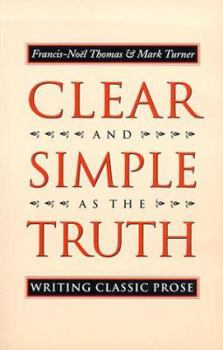Clear and Simple as the Truth: Writing Classic Prose
Select Format
Select Condition 
Book Overview
For more than a decade, Clear and Simple as the Truth has guided readers to consider style not as an elegant accessory of effective prose but as its very heart. Francis-No?l Thomas and Mark Turner... This description may be from another edition of this product.
Format:Paperback
Language:English
ISBN:0691029172
ISBN13:9780691029177
Release Date:November 1996
Publisher:Princeton University Press
Length:240 Pages
Weight:0.75 lbs.
Dimensions:0.7" x 5.5" x 8.5"
Customer Reviews
5 ratings
Style as Substance
Published by Thriftbooks.com User , 14 years ago
After reading several of the comments here, I see that readers who took this book as a weak or failed guide to writing have missed the point. I should know; I acquired this book for Princeton University Press on the basis of reading the introduction and listening to the authors explain why this is NOT a Strunk & White, useful as that may be. They wanted readers to rethink style, not as a tool or an adjunct of writing, but as substance, married with the message. Therefore, they suggest the classic style (with historical underpinnings in French literature) as a way of developing an attitude about what one is saying. The style flows from that. Therefore, they don't present a 10-point plan for improving writing, or a step-by-step how-to manual. Rather, their museum of examples shows how style, classic and not, has worked, or not, in all kinds of writing--from formal to informal. Of course classic style is not for every situation, but it is very effective in achieving its ends. For me, the book isn't just about writing classic prose. It's about thinking of style--any style--as integral to the message.
One of the best on the vexing topic of style
Published by Thriftbooks.com User , 18 years ago
Turner and Thomas (T & T) offer an overview of that which requires a lifetime of practice: writing as a activity done in a certain manner with the aid of a certain set of enabling conventions. Contrary to the usual surface-level gimmicks, quasi-metaphysical hooey, and self-contradictory cliches that plague the teaching of style, T & T offer an approach that can actually be useful, coherent, and intellectually polished. They make no bones about their so-called classic prose's strengths and weaknesses. At any rate, classic prose in the T & T mode is probably the most useful manner of writing (ONE manner, not the ONLY manner, as T & T make quite clear) that can be taught or learned within the constraints of the composition classroom in an institutional setting. Those yearning, as I did, for more development of some of the key ideas and a suite of pedagogical applications can turn to T & T's website. Google the title of the book and you will find it.
How to Think about Style
Published by Thriftbooks.com User , 19 years ago
Thomas and Turner offer a provocative approach to writing style. This is not a manual or reference book that you can consult for simple directions on correcting grammar or streamlining sentences. Instead, the authors examine the fundamental questions that underlie the stylistic choices we make. (For example, what is the nature of truth? what is the relationship between language and the truth?) The book focuses on the style they call "classic prose," but they also describe (and give both good and bad examples of) other prose styles, and they are honest about the shortcomings of classic prose and the situations when other styles are better suited to the purpose of writing. The book would be more useful if there were more direct discussion of how specific surface features of an example relate to the author's philosophical stance, but it is a rewarding and thought-provoking text that may well change how you think about writing.
Delightful, informative, and useful
Published by Thriftbooks.com User , 22 years ago
Contrary to other reviewers, I have found this book wonderfully useful. It was not written as a how-to book, but the style -- indeed the whole philosophy that the truth is both pure and simple -- is refreshing and enticing. While Oscar Wilde didn't believe it, neither did he believe half of what he himself said. The writing is clear and pure. Classic style does not portend to talk down to the reader, but assumes that she is capable of understanding the concepts presented. It is a style to intelligently present information and ideas for the consumption of the intelligent. And, as the authors rightly point out, there are frequently other styles appropriate for other things. Unlike other books about writing style (the best of which is perhaps Williams' "Style"), this book does not give rules or advice, but simply observes and inspires.To me, this book is the prosaic equivalent of Edward Tufte's books on visual design (and Robert Bringhurst on typography). I re-read these books regularly, and try to follow their intelligent examples.
Excellent stuff.
Published by Thriftbooks.com User , 25 years ago
Contrary to what another reviewer said, most of the book is indeed written in the Classic Style, and it does in fact tell you how to write in it, at least to the degree that that is possible: it tells you the mindset that must underlie it. Any writing consistent with the classic prose mindset, crafted according to its assumptions, must perforce be classic prose.




